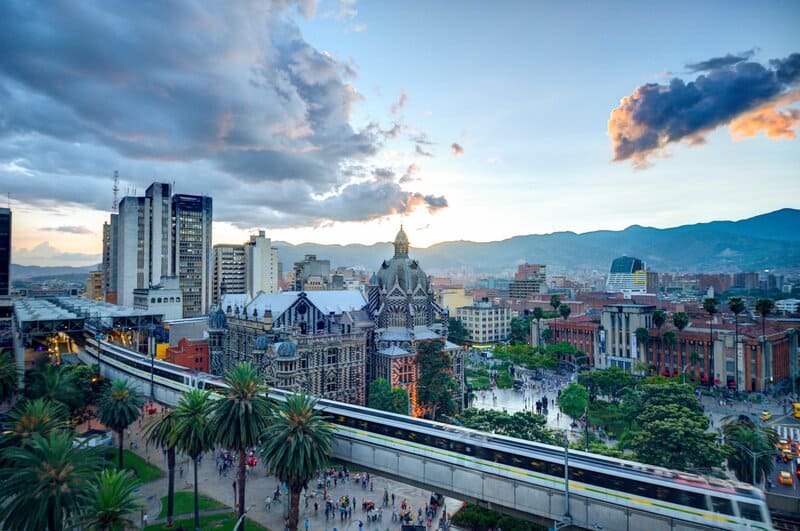The people of Medellin are hugely proud of their clean, modern, innovative and expansive metro network. Inaugurated in 1996, the Metro has grown to include two elevated metro lines, six commuter cable cars, a tram line and a BRT Metroplus bus route with stations. You can access the whole network with your Civica card.
Medellin was the first city in the world to use cable cars as a public transport solution and this has now been adopted around the world. The metro is a great way to travel quickly, comfortably and enjoy amazing views of the city. It is air-conditioned, carefully managed and always immaculately clean.
I have lived in Medellin for almost 15 years and I will explain how to make the most of the metro and why you definitely should during your stay.
Taking the Metro in Medellin: Pros and Cons
✅ Pros of taking the Metro in Medellin:
- Often the metro is the quickest way to cross the city, particularly at rush hour
- You can use the metro to get up until the hills on the cable cars
- The full network is always impeccable clean and well maintained
- It is a very cheap and simple way to travel in the city
- You only have to pay once to take multiple metro lines and the cable cars
- There are great views of the city from the elevated metro and metrocable
- The metro is air conditioned and usually very comfortable
❌ Cons of taking the Metro in Medellin:
- During rush hour it can get incredibly busy, particularly changing at San Antonio station
- If you have to buy a ticket at the station during peak times the lines can be very long
- The network is varied and extensive but there are areas to the west that aren’t covered without changing to buses
- You have to be careful for pickpockets during busy times
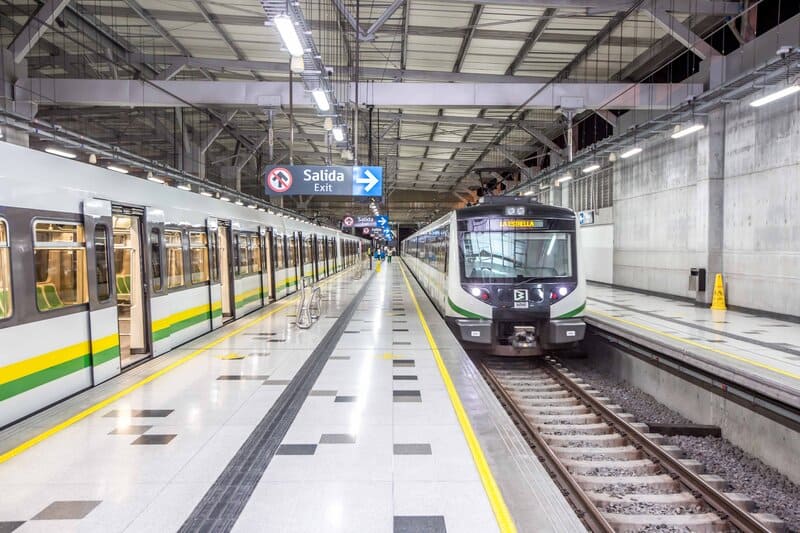
How to Take the Metro in Medellin?
You can use the metro by using a generic or personalized Civica Card, which is the payment system across most of Medellin’s transport network. This is something similar to the Oyster Card in London or the MetroCard in New York.
The cost of a generic card is 10,000 COP (US$2.40). You can pay for a new unregistered Civica card at most stations and then you top up the amount you need for the journeys.
You tap in when you enter the metro, bus or cable car. You do not need to tap out when you leave the system as there is only one set price per journey.
In 2024 the price for a single trip with a non-personalized card is 3,280 COP (US$0.80).
A personalized Civica card is available free of charge and can be acquired at Itagui, Niquia, San Antonio and San Javier stations Monday to Friday from 6.30am to 8.30pm or Saturday from 9.30am to 4.30pm. You will need to present an ID for this which can be a Colombian cedula, passport, drivers license, university photo ID or birth certificate. The Civica will have your name printed on it and can be topped up. A single journey with a personalized Civica costs 2,880 COP (US$0.70), saving US0.10 per trip.

The Civica can be used on:
- the metro
- the cable cars (metrocable)
- the tram (tranvia)
- the BRT bus network (metroplus)
- the white metro buses.
You can switch between much of the network by only paying for one journey, such as taking the metro and then the cable car.
If you go from the metro to one of the buses then you will pay again but at a discounted rate given they are considered “integrated” as an extension of a single journey.
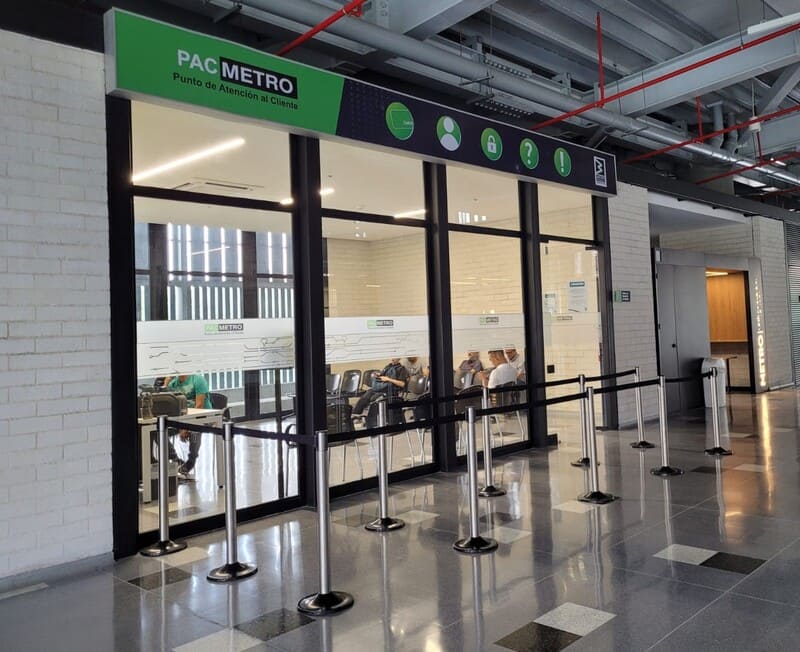
Price and Schedule
- From Monday to Saturday the metro operates from 4.30am to 11.00pm.
- On Sunday and on national holidays most lines operate 5am to 10pm but Line K to Santo Domingo is 8.30am to 10pm and the remaining cable cars start operation at 9am.
- Line L, the cable car that links to Parque Arvi, the ecotourist park, runs from 9am to 6pm on Tuesday to Saturday. On Sunday and on national holidays it operates 8.30am to 6pm. The line is closed on Monday unless there is a national holiday on Monday, then it is closed on Tuesday.
Prices with registered personalized Civica:
- Single journey: 2,880 COP (US$0.74)
- Cable car journey to Parque Arvi (Line L): 12,500 COP (US$3,19)
- Integrated journey including external bus and metro network: 3,470 COP (US$0,89)
- Integrated trip with external bus, metro and another external bus: 4,060 COP (US$1.04)
- Integrated trip with metro, external bus and second metro trip: 4,650 COP (US$1.19)
Prices with unregistered Civica:
- Single journey: 3,280 COP (US$0.84)
- Cable car journey to Parque Arvi (Line L): 12,500 COP (US$3.19)
- Integrated journey including external bus and metro network: 3,870 COP (US$0.99)
- Integrated journey with external bus, metro and second external bus: 4,460 COP (US$1.14)
- Integrated trip with metro, external bus and second metro trip: 5,050 COP (US$1.29)
The integrated journeys seem complicated but it will all be calculated by your Civica when you enter the network or bus. Basically, the card will add a significant discount on the second leg of your journey if you take the metro and then a white metro bus.
How to Purchase a Metro Ticket / Card
⚠️ Warning: They no longer sell tickets for single journeys on the metro. You will have to get a Civica card.
You can add funds to your Civica:
- At a ticket booth
- At one of the 136 machines in stations
- At one of the 1,200 Gana charging booths around the city
- Online using the Civica app (Google Play | Apple Store). Note: you can only pay or top up on the app using PSE (service which means you can transfer from Colombian accounts). The app doesn’t have an option in English.
- Through banking platforms such as DaviPlata, Nequi or Bancolombia. On the app there is the option to register with cedula, foreign cedula or ID but I have never been able to make it work with my details. There isn’t an issue with the personalized cedula if you sign up at the station but the app seems to be more tricky.
It is also now possible to pay using a QR code generated on the Civica app. Even when not connected to the internet you can generate a QR code on the app which can be scanned at the ticket machine to pay for a journey.
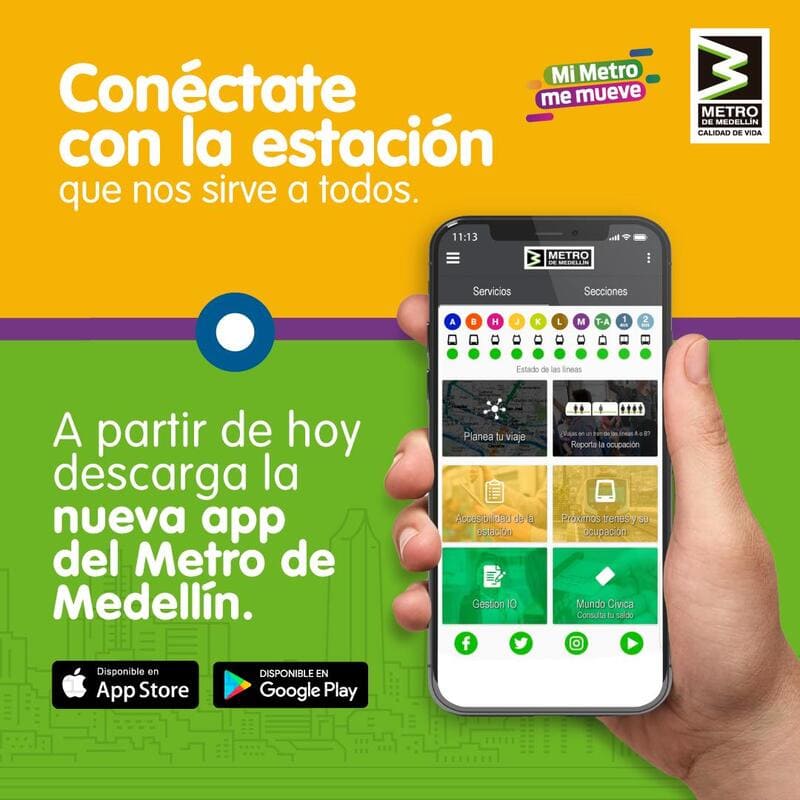
I would recommend avoiding the station kiosks, particularly at peak times because there can be lines all the way out and across the bridge. The increased payment options have made this far more manageable but a lot of people still choose to pay by cash at the station.
My recommendation is to get the Civica early and then you can use the self-service machines to top up and you can get by without speaking much Spanish.
Medellin Metro Map
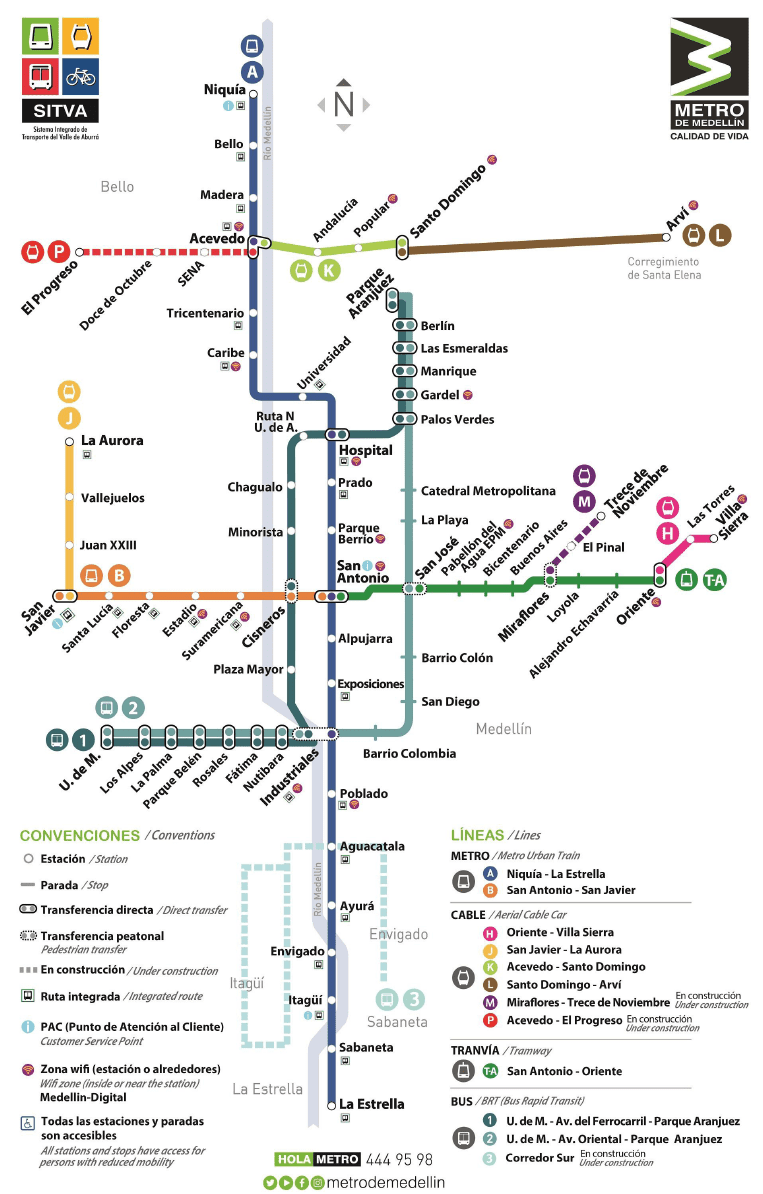
🚇 Line A: Niquia – La Estrella (Metro train)
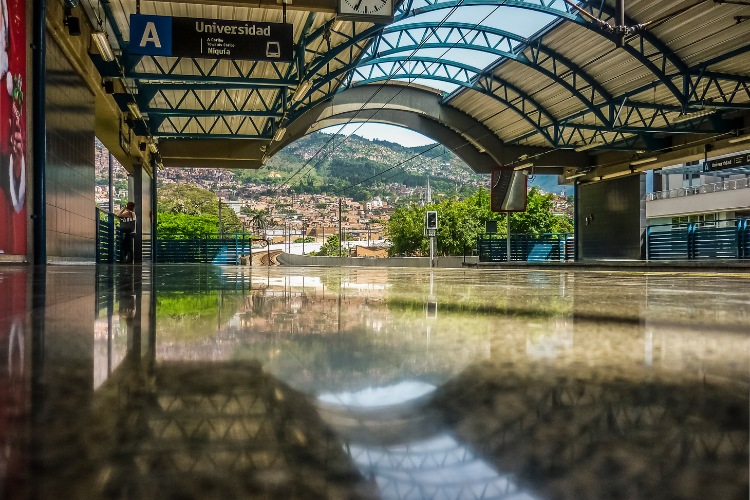
This is the first, the longest and most important metro line in the city. The line runs North to South alongside the river, moving further east from Industriales to Caribe to connect with the busy downtown area.
San Antonio is the main central station which has links to the tram and Linea B, the second, shorter metro line.
Line A runs through municipalities of La Estrella, Sabaneta, Itagui and Envigado before arriving at Poblado station in the South and then out beyond Medellin to Bello and Niquia in the north.
Total journey time from North to South is around 40 minutes and trains arrive on average every 3 minutes.
Linea A is the green line on the map. You can connect to cable car Line P in Acevedo to the north as well as Line 1 of the Metroplus BRT in Hospital station and lines 1 and 2 of the Metroplus at Industriales.
🚇 Line B: San Antonio – San Javier (Metro train)
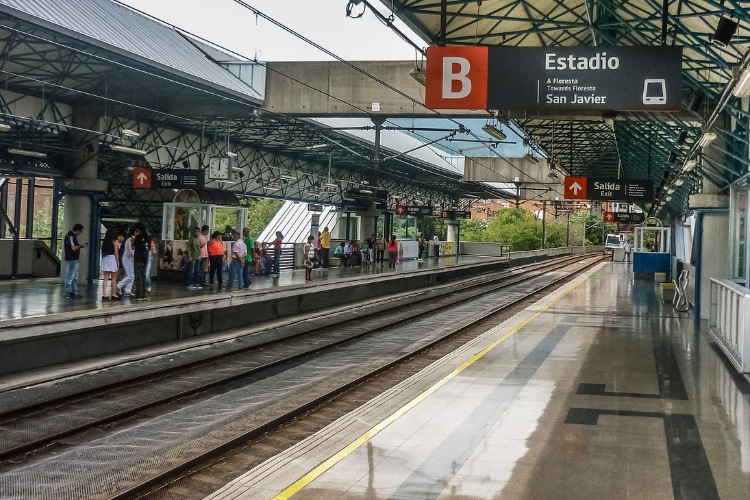
Line B runs from San Antonio station in the center of the city out to San Javier in the west. The second metro line was launched a year after the first in 1996. It takes around 15 minutes to get from San Antonio out to San Javier with trains every 4 minutes and 45 seconds.
Line B connects to the main stadium and sports complex at Estadio station. This is also close to La 70, a popular street for bars and clubs at the edge of Laureles. The final stop San Javier has the Line J cable car system and is in Comuna 13, where you can take the graffiti tour.
🚇 Line J: San Javier – La Aurora (Cable car)
Line J was the second cable car route to open in the city in 2008. The route runs from San Javier station in the west up into the hills with four stops.
Cable cars come through the station every 12 seconds and it takes 12 minutes to get to the final station at the very limit of the city, up in the hills.
The final station La Aurora is actually in the adjoining municipality of San Cristobal.
🚇 Line K: Acevado – Santo Domingo (Cable car)
Line K is a 2km cable car that can take 3,000 passengers per hour from Acevado station up to Santo Domingo in the eastern hills of the city. Cable cars arrive every 12 seconds and it takes 9 minutes to get to the top with four stations on the route.
Santo Domingo has an excellent view of the city and it can be a good spot to take photos and grab a drink. It is relatively safe if you stay in the area close to the station. You can also change at San Domingo cable car station to Line L which takes you out to Arvi Parque.
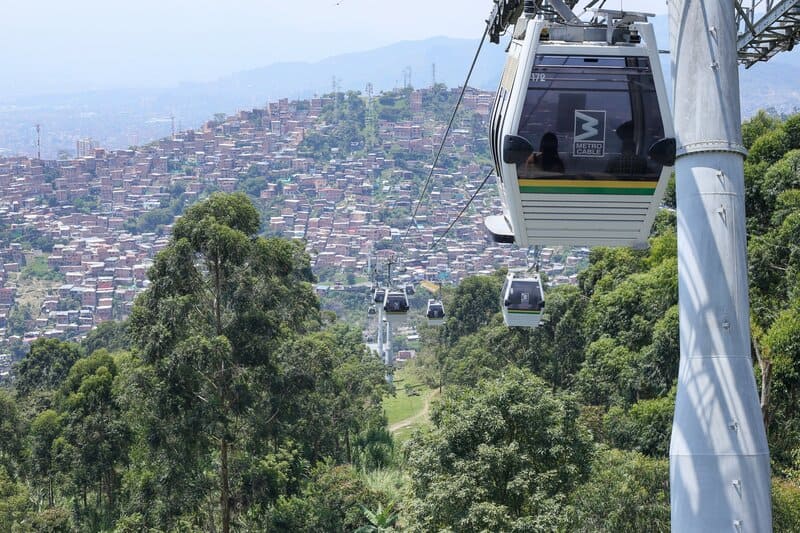
🚇 Line L: Santo-Domingo – Arvi (Cable car)
This line travels from Santo Domingo, a busy neighborhood high up in the hills, out beyond the city across 4.6km of forest to a natural ecotourism park.
Parque Arvi is a 16-hectare natural park with lakes, trees, wildlife and outdoor activities. It is a very relaxing place to spend the afternoon in the fresh air away from the city. The total journey time is around 15 minutes and there is an additional cost to use this cable car when paying with your Civica.
🚇 Line H: Oriente – Villa Sierra (Cable car)
This cable car was launched in 2016 and connects the top of the tram line with the neighborhood of La Sierra. The line is shorter with a total journey time of 5 minutes to pass the three stations on the way to the top.
La Sierra has been one of the less stable parts of the city and you should avoid walking around outside the station if you go up the cable car.
🚇 Line M: Miraflores – Trece de Noviembre (Cable car)
Line M is another new cable car route that was opened in 2019 to link the new tram line to the neighborhoods up in the hills. It takes 4 minutes to travel from Miraflores tram station up to Trece de Noviembre neighborhood.
🚇 Line P: Acevedo – El Progreso (Cable car)
The most recent cable car Line P was inaugurated in 2021 to connect Acevedo, north of the center on Line A metro, with El Progreso in the west of the city. The new Line P cable cars are slightly larger, with a capacity of 12 people, and can transport up to 4,000 passengers per hour.

My Recommendations When Taking the Metro in Medellin
- If possible, always avoid rush hour (7am – 9am and 5pm – 7pm). The trains can get very full and the platforms can be crowded. Changing from Line A to Line B at San Antonio is particularly hectic.
- Get a Civica on your first day and if you are at a station that offers the service, go for the personalized option. This is free rather than 10,000 COP and will save money on all of your journeys.
- As with all metro systems, always be aware of pickpockets and if you are standing with a backpack then take it off or be very careful about what is happening behind.
- Definitely take one of the cable cars up to get incredible views of the city traveling up the hill and from the high stations. You can travel from Line A of the metro, up the cable car to the station at the top and then back down by only paying once or you can leave at the top. Be aware that many of the cable cars link to the poorer parts of town, so don’t wander too far from the station. Cable cars will also be very busy at peak times.
FAQ
➡️ Is the Medellin Metro safe?
Generally, the metro is very safe, even into the evening. There are soldiers and police officers present at most of the stations with security cameras that are monitored across the network.
If you try to eat food security will stop you, if you step over the yellow line there may be a tannoy announcement. This gives you a sense of how carefully the network is policed and managed.
You do however need to take care with pickpockets and late into the evening it can be quite quiet which may feel intimidating.
➡️ Is there a metro going to Medellin airport?
There is no metro line connecting the city to the international airport in Rionegro. You can get the metro to Exposiciones station and then walk 10 minutes to San Diego mall where you can take a bus.
Another option is to take an Uber or a taxi.
➡️ Is the Medellin Metro busy?
During peak hours the metro can be very busy. This is particularly tricky at San Antonio central hub station when transferring to the tram or from Line A to Line B. If you can avoid traveling during peak hours then I strongly recommend this.
The cable cars are also much busier before 9am and after 5pm each day.
➡️ What time does the metro operate in Medellin?
The metro operates from 4.30am to 11.00pm on Monday to Saturday. On Sundays and national holidays most lines operate 5am to 10pm but Line K to Santo Domingo is 8.30am to 10pm and the remaining cable cars start operation at 9am.
➡️ Can you take the metro without a Civica card?
You can travel in Medellin using your free personalized Civica card or by paying 10,000 COP for a non-personalized Civica “Eventual”. They no longer sell tickets for single journeys on the metro.
➡️ Can you transfer between different metro lines or cable cars?
It is possible to travel from La Estrella metro station in the South to Santo Domingo cable car station up in the hills of the east by only paying US$0.70. You are only charged for entering the network and there are transfer internal transfer stations direct from the metro.
If you take a white metro bus make sure you pay with your Civica, you will then receive the reduced price as part of an integrated route. For most of your journeys, you will only pay once or receive a substantial discount, even if you change the mode of transport.
➡️ Can you navigate the metro system if you don’t speak Spanish?
Yes. Despite the expansion to include cable cars and trams, the Medellin metro system remains very simple. The main line runs from North to South with other lines connecting from this. There are plenty of signs which will say towards La Estrella (South) or towards Niquia (North).
Announcements on the metro are made in both Spanish and English. The only potential challenge will be when topping up your Civica at the booth, but google the number you want or go with tried and trusted hand signal for the number of thousand (“mil”) you need.
